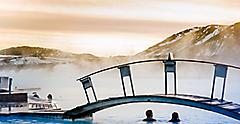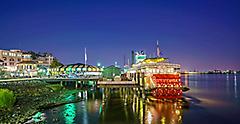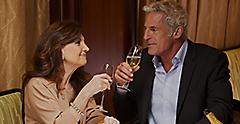
Champagne
Nothing says "celebration" like this French classic.

Where Does It Come From?
The word "champagne" is now synonymous with bubbles. However, the original wine made during the 5th century in the Champagne region of northeastern France was still and pink in color compared to today's golden shade. Although only wine produced in Champagne can officially bear that name, you can still enjoy exported bottles of the quintessential sparkling wine around the world, including on your next cruise. Ask to see the label to learn more about your bottle or glass!
How Is It Made?
Like still wine, this sparkling wine begins with the fermentation of grapes — Chardonnay, Pinot Meunier or Pinot Noir. What you might not realize is that unlike still wine, this sparkling beverage goes through a second process, after which it's immediately bottled (as opposed to being left in barrels) in order to trap the carbon dioxide gas that becomes the beverage's famous bubbles. The entire two-step process is known as Méthode Champenoise, translated literally as the "Champagne-type method."
What Does It Taste Like?
You'll never forget your first "real" glass of these bubbles. Many popular brands bear the designation of "brut," which signifies a very dry or even sour flavor, far different from still wines made with Chardonnay or Pinot Noir grapes. Certain of these sparkling wines are also made using pink rosé wine or in varieties that range from more neutral "sec" and "demi-sec" to the very sweet "doux." You might notice that a good glass of this sparkling wine smells like freshly baked bread!
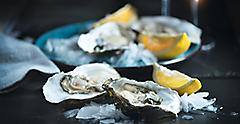
Pairing It With Food
There's nothing wrong with enjoying a glass of bubbles à la carte, but it's much more satisfying if you pair it with something. Like many white wines, this sparkling beverage pairs well with shrimp and other shellfish, including scallops and oysters. Not surprisingly, many French foods also make great accompaniments to champagne, whether you enjoy yours with a board of Brie cheese or with some pâté spread on toasted crackers. If you decide to order a glass onboard your next cruise, don't be shy about asking the bartender for his or her pairing recommendations!
Prosecco
This is Italy's festive, fun take on bubbles.
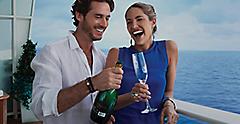
Where Does It Come From?
Italy is more relaxed than France as a general rule, and the specific rules for the country's sparkling wine are no different. One reason you might've found prosecco to be cheaper is that its production takes place in a much larger area — nine provinces, which are split between the regions of Veneto and Friuli Venezia Giulia. A notable exception to this rule is the high-end Prosecco Superiore, which comes only from specially designated producers (origine controllata in Italian) in the towns of Conegliano, Cartizze and Valdobiaddene. Note that Spumante, which is the generic Italian word for sparkling wine, doesn't necessarily adhere to any productions.
How Is It Made?
You might suspect that prosecco is made differently than champagne, and you're right to think that. In addition to originating from the prosecco grape, Italy's sparkling wine also undergoes a different fermentation process. Like Méthode Champenoise, the so-called Charmat method occurs in two steps. However, the secondary fermentation process occurs in a pressurized tank as opposed to inside the bottle. This is why prosecco generally loses its fizz faster than other sparkling options. Think of it as a convenient excuse to drink it faster!
What Does It Taste Like?
Prosecco also tends to be labeled brut, though you might've noticed that proseccos taste sweeter than champagnes. This is because of prosecco grapes, whose fruity flavors ranging from honeydew melon and green pear can linger even after fermentation. You might have tasted (or rather felt) another of prosecco's trademarks as well: Its so-called "tingle," which is a result of its high acid content. Because of this characteristic, many people believe prosecco is the best base for brunch cocktails such as the mimosa and the Bellini, made by mixing sparkling wine with orange juice and peach nectar, respectively.
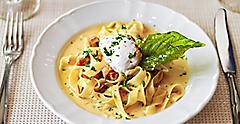
Pairing It With Food
You'll find prosecco to be a versatile pairing beverage, which goes especially well with chicken, pork and seafood dishes, and not just Italian ones, although a glass of Italian bubbles with a plate of chicken parmigiana or a bowl of creamy pasta carbonara sounds like a nice combination indeed. Many prosecco drinkers also pair sweeter versions of the wine with spicy dishes from Thai noodles to Indian curries, as the sugar and acid tend to balance out the heat in these foods. If you're simply looking to snack as you enjoy your prosecco, choose classic Italian prosciutto ham or something more universal like roasted almonds.
Cava
You don't have to wash down your tapas with sangria.
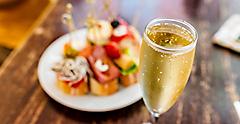
Where Does It Come From?
Cava is a Spanish sparkling wine with looser rules. In the past, cavas (and modern, high-end D.O. or "Denominación de origen" ones) came only from a small town in the Catalonia region, which is home to Barcelona. Today's cavas not only come from Spanish regions as far and wide as Aragon and Rioja, but they have expanded their source beyond Macabeo, Parellada and Xarel-lo grapes to include Chardonnay and Pinot Noir as well.
How Is It Made?
Cava is produced using the Methode Champenoise, which means that cavas also tend to stay bubbly for a long time. Cavas need to be aged for a minimum of nine months, but some D.O. varieties can mature for much longer, including Cava Gran Reserva, whose aging period is a whopping 30 months. The alcohol content of cava can vary but can never be less than 9% or greater than 13%.
What Does It Taste Like?
If you've ever tasted cava, you've probably noticed it has a relatively mild flavor, neither as dry as champagne nor as sweet and tangy as prosecco. Officially, cava come in seven varieties that range from brut to dulce (sweet), but most cavas (as is the case with champagnes and proseccos) are bruts. If you're lucky enough to order a Gran Reserva, you might notice a nutty or even smoky flavor, which some wine professionals describe as evoking baked apple. If the bar onboard your cruise ship has multiple cavas, ask the bartender to sample different ones and choose your favorite.
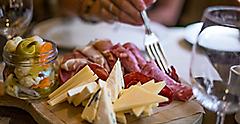
Pairing It With Food
Although most people enjoy tapas like the tortilla española potato omelette and gambas al ajillo garlic shrimp with sangria (it often comes with them for free, so why not?), cava makes a great companion to Spain's famous small plates, especially chicken and seafood ones. Many Spaniards pair cava with greasier foods like barbecued pork ribs and Jamon Ibérico cold cuts, since they find the bubbles to have a scrubbing action inside the mouth. Some people also pair cava with Spanish cheeses (especially sheep's milk Manchego) and, perhaps more interestingly, with vegetables like artichokes and asparagus.
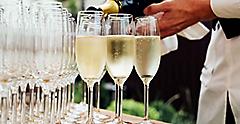
How To Serve And Store Sparkling Wine
Regardless of which country's take on sparkling wine you choose to enjoy, some universal rules apply to serving and storing it. To start, you should note that there will be some pressure built up inside the bottle, so you'll want to be careful when you open it. After removing any plastic wrapping and twisting off the wire cage that cradles the cork, point the bottle away from you (and from anyone else standing within a few yards!) and slowly turn the cork counter-clockwise. Although quickly opening the bottle can create a dramatic "pop," it's safer to be more gentle, especially if you're inexperienced.
Once the bottle is open, you can pour your champagne or cava into a flute (a tall and narrow wine glass) and your prosecco into a so-called "tulip" glass, which is shaped just like the flower. Since the cork expands dramatically in size once you remove it, you won't be able to re-cork your bottle in the event you don't finish all the wine. Instead, you'll want to have a champagne bottle stopper handy. These take a few forms but most often feature metal wings that open and then flap down to clamp the stopper into the body air-tight.

Other Sparkling Wines
A large percentage of the world's sparkling wines come from France, Italy and Spain, but they're not the only ones. For example, "California Champagne" comes from Napa Valley and white wines (usually Chardonnay and Pinot Noir, as is the case in France) are aerated using the same Méthode Champenoise by which vintners in northeastern France create their own bubbling masterpieces. New Zealand winemakers, on the other hand, often put the word "sparkling" in front of several different types of wine.
While your cruise ship will be well-stocked with champagne, prosecco or cava (or, more ideally, all three), the places the boat calls during the trip might not be. If you're craving bubbles but can't find them in a restaurant or bar, you can approximate the sensation by making your own wine spritzer. You can use a red, wine or rosé as a base, then add club soda, ice and maybe even some fresh fruit to your glass. It's not the same as real sparkling wine (certainly not if you're a grape farmer), but it'll do the trick until you can get back on board.
Get Royal Deals, Sign Up Today




